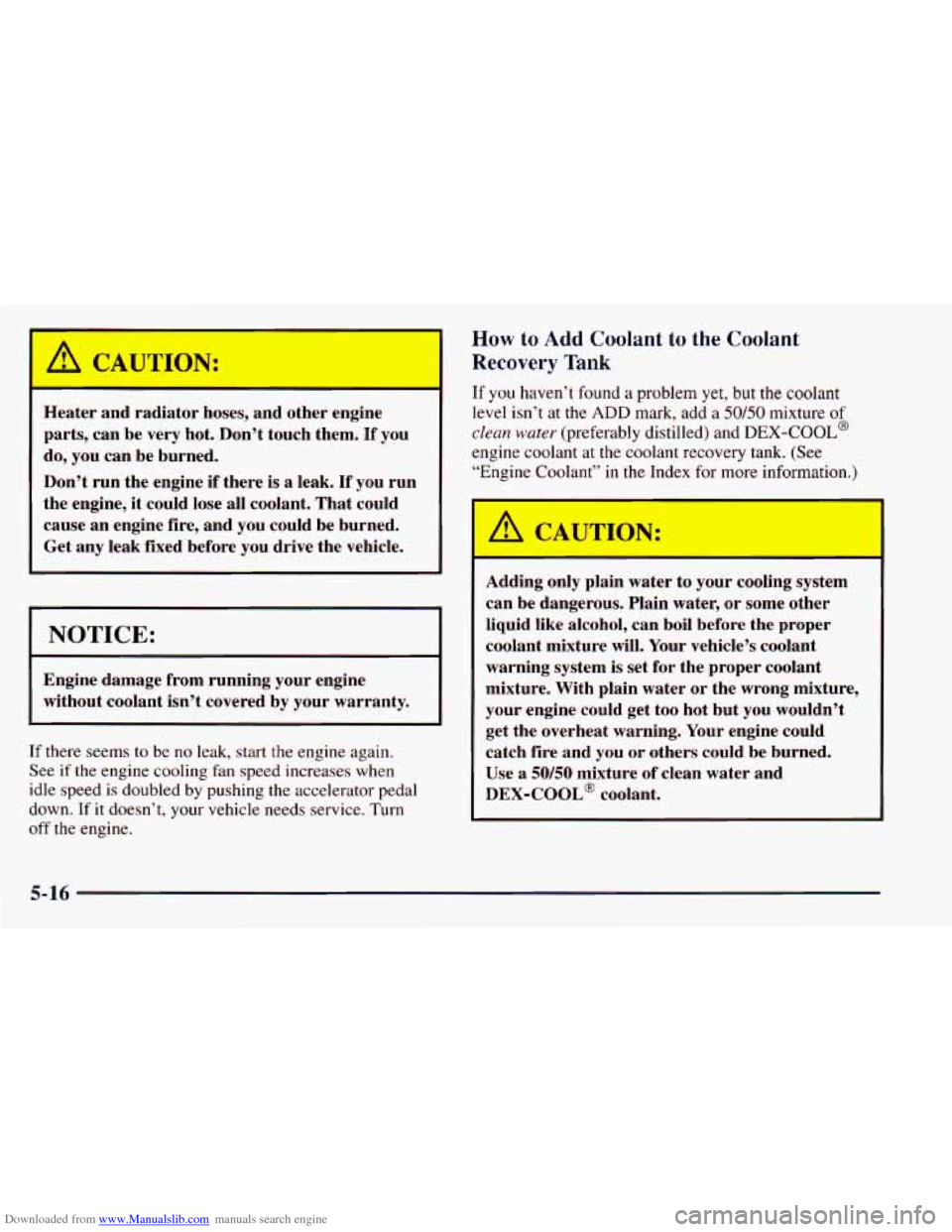adding oil CHEVROLET ASTRO 1998 2.G Owners Manual
[x] Cancel search | Manufacturer: CHEVROLET, Model Year: 1998, Model line: ASTRO, Model: CHEVROLET ASTRO 1998 2.GPages: 414, PDF Size: 21.46 MB
Page 238 of 414

Downloaded from www.Manualslib.com manuals search engine [6h, CAUTION:
Heater and radiator hoses, and other engine
parts, can be very hot. Don’t touch them.
If you
do, you can be burned.
Don’t run the engine if there is
a leak. If you run
the engine, it could lose all coolant. That could
cause an engine fire, and you could be burned.
Get any leak fixed before you drive the vehicle.
I NOTICE: I
Engine damage from running your engine
without coolant isn’t covered by your warranty.
If there seems to be no leak, start the engine again.
See if
the engine cooling fan speed increases when
idle speed is doubled
by pushing the accelerator pedal
down. If it doesn’t,
your vehicle needs service. Turn
off the engine.
How to Add Coolant to the Coolant
Recovery Tank
If you haven’t found a problem yet, but the coolant
level isn’t at the
ADD mark, add a 50/50 mixture of
clean water (preferably distilled) and DEX-COOL@
engine coolant at the coolant recovery tank. (See
“Engine Coolant” in the Index for more information.)
A CAUTION:
Adding only plain water to your cooling system
can be dangerous. Plain water, or some other
liquid like alcohol, can boil before the proper
coolant mixture will. Your vehicle’s coolant
warning system is set for the proper coolant
mixture. With plain water or the wrong mixture,
your engine could get too hot but you wouldn’t
get the overheat warning. Your engine could
catch fire and you
or others could be burned.
Use a
50/50 mixture of clean water and
DEX-COOL@ coolant.
5-16
Page 288 of 414

Downloaded from www.Manualslib.com manuals search engine NOTICE:
When adding coolant, it is important that you use
only
DEX-COOL@ (silicate-free) coolant.
If’ coolant other than DEX-COOL is added to the
system, premature engine, heater core or
radiator corrosion may result. In addition, the
engine coolant will require change sooner
-- at
30,000 miles (50 000 km) or 24 months,
whichever occurs first. Damage caused by the use
of coolant other than DEX-COOL@ is not
covered by your new vehicle warranty.
I
What to Use
Use a mixture of one-half clean water (preferably
distilled) and one-half
DEX-COOL@ coolant which
won’t damage aluminum parts.
If you use this mixture,
you don’t need
to add anyth‘ ; else.
Adding only plain water to your cooling system
can be dangerous. Plain water, or some other
liquid like alcohol, can boil before the proper
coolant mixture will. Your vehicle’s coolant
warning system is set for the proper coolant
mixture. With plain water or the wrong mixture,
your engine could get too hot but you wouldn’t
get the overheat warning. Your engine could
catch fire and you or others could be burned.
Use a
50/50 mixture of clean water and
DEX-COOL@ coolant.
6-26
Page 401 of 414

Downloaded from www.Manualslib.com manuals search engine Cooling System .................. ... 5-15
Customer Assistance for Text Telephone Users ......... 8-4
Courtesy Transportation
......................... 8-8
Cruise Control
................................. 2-34
Customer Assistance Information
................... 8- I
Customer Satisfaction Procedure .................... 8-2
Damage. Finish
............................... 6-57
Damage. Sheet Metal ............................ 6-57
Daytime Running Lamps
......................... 2-38
Daytime Running Lamps Indicator Light
............ 2-66
Dead Battery
................................... 5-3
Defects. Reporting Safety
................... 8- IO. 8- 1 1
Defensive Driving ............................... 4-2
Defogger. Rear Window
.......................... 3-8
Defrosting
..................................... 3-6
Dimensions. Vehicle
............................ 6-69
Dome Lamps
.............................. 2-39
Door Front
.......... ........................ 2-4
Rear
........................................ 2-4
Sliding
..................................... 2-10
Drive Position ................................. 2-21
Driver Position
................................. 1 - I 8
Driving
City
........................................ 4-17
Defensive
.................................... 4-2
Drunken
..................................... 4-2
Freeway
.................................... 4-18
InaBlizzard
................................. 4-24
In Foreign Countries
........................... 6-5
IntheRain .................................. 4-15
Locks
....................................... 2-6 Night
...................................... 4-13
OnCurves
................................... 4-9
On Grades While Towing a Trailer
............... 4-35
On
Hill and Mountain Roads .................... 4-21
OnSnowandIce ............................. 4-23
Through Water
............................... 4-17
WetRoads
.................................. 4-15
Winter
...................................... 4-22
With
a Trailer ................................ 4-33
Drunken Driving
................................ 4-2
Electrical Equipment. Adding
.......... 2-18. 3-28. 6-60
Electrical System
............................... 6-60
Engine
........................................ 6-9
Coolant
..................................... 6-25
Coolant Heater
............................... 2-18
Coolant Level Check
.......................... 7-41
Cooling System Capacity
....................... 6-67
Cover
...................................... 6-15
Exhaust
................. 2-13.2-27.2.30.4.25. 4.33
FuseBlock
.................................. 6-64
Identification
................................ 6-59
OilLevelCheck
.............................. 7-41
Overheating
................................. 5-13
Running While Parked
......................... 2-27
Specifications
................................ 6-67
Starting
..................................... 2-17
Temperature Gage
............................ 2-61
Engineoil
.................................... 6-10
Adding ..................................... 6-12
Additives
................................... 6-14
Checking
................................... 6-11
Pressure Gage
................................ 2-64
9-3